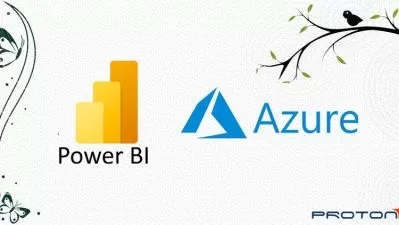Data-Viz with R and GGplot2
54:21
Description
An accessible introduction to data viz with R and GGplot2. Learn how to make custom interactive plots!
What You'll Learn?
- Build on existing skills in R
- Create a wide variety of publication quality plots!
- Improve and modernize your graphics workflow
- Gain confidence with interactive graphics and advanced plots
Who is this for?
What You Need to Know?
More details
DescriptionThis course offers a comprehensive introduction to ggplot2, the powerful and flexible data visualization package in R, widely used for creating publication-ready graphics. Starting from the basics, the course progresses through various graph types, aesthetic options, and customizations. By the end, students will be equipped to produce both simple and sophisticated graphics, enabling them to communicate insights effectively through data. The course uses real-world examples from the popular penguins dataset and provides practical, hands-on learning to build a solid foundation in data visualization with ggplot2.
Lecture 1: Welcome
The course begins with a welcoming session that introduces the goals, structure, and scope of the course. We'll cover the prerequisites, learning objectives, and how the skills developed will translate into creating meaningful, professional-quality graphics in R. Participants will also get an overview of the ggplot2 ecosystem and how it fits within the tidyverse for data science in R.
Learning Objectives:
Understand the course layout and expectations.
Gain an overview of the ggplot2 package and its place within the R ecosystem.
Lecture 2: Introduction to ggplot2
In this lecture, we dive into the fundamentals of ggplot2, focusing on its underlying structure and core principles. Students will learn how ggplot2 builds plots layer by layer, mapping data to visual properties through the grammar of graphics. We'll introduce basic plot types using the penguins dataset and cover foundational concepts like setting up ggplot() and adding geometric layers (geoms) to construct a plot.
Topics Covered:
Structure of ggplot2: data, aesthetics (aes), and geometries (geom_).
Basic scatter plots, bar plots, and line graphs.
Layering concepts: how each layer contributes to building a plot.
Hands-on: Creating basic plots using ggplot2.
Learning Objectives:
Understand the grammar of graphics structure in ggplot2.
Create simple plots by mapping data to aesthetics and adding geometric layers.
Lecture 3: Available Graphs and Options
Building on the previous lecture, this session introduces a variety of graph types available in ggplot2 and explores options for customizing plot elements. We'll examine different plot types and cover how to select the right graph to represent specific types of data. Additionally, students will learn essential options to refine their graphs, such as setting axis limits, modifying color schemes, and adjusting visual attributes for clearer communication.
Topics Covered:
Overview of available ggplot2 geoms: histograms, box plots, density plots, and more.
Customizing color, shape, and size for better visual clarity.
Setting plot dimensions, scales, and axis limits.
Hands-on: Experimenting with different graph types and adjusting basic options.
Learning Objectives:
Identify and use various plot types in ggplot2 to represent data effectively.
Customize visual properties to improve the readability and aesthetic appeal of graphs.
Lecture 4: Labels, Legends, and Details
In this lecture, we focus on adding contextual elements to make graphs more informative and professional. Students will learn how to manage labels, legends, and detailed customizations to communicate the story behind the data. We’ll also cover how to create custom themes, apply different color palettes, and fine-tune plot elements to align with presentation or publication standards.
Topics Covered:
Adding titles, subtitles, captions, and annotations.
Customizing legends: position, style, and order.
Theming and color palettes: using theme() for layout adjustments.
Hands-on: Enhancing graphs with descriptive labels and stylistic choices.
Learning Objectives:
Make plots more interpretable with well-crafted labels and legends.
Apply custom themes to achieve consistent and visually appealing designs.
Lecture 5: Final Thoughts and Advanced Graphics
The final session consolidates core concepts and introduces advanced ggplot2 features, including faceting for grouped visualizations, using complex scales, and integrating interactivity. We’ll explore how to create multi-panel plots to display comparative data and briefly introduce packages that expand ggplot2's capabilities, such as plotly for interactive charts.
Topics Covered:
Faceting for grouped comparisons with facet_wrap and facet_grid.
Advanced scales and custom mappings.
Intro to interactivity: bridging ggplot2 with plotly.
Hands-on: Combining multiple plots and exploring interactive visualizations.
Learning Objectives:
Create multi-panel plots for comparing subsets of data.
Understand techniques for creating advanced and interactive graphics.
Conclusion
By the end of this course, students will have gained a thorough understanding of ggplot2, from constructing basic plots to customizing advanced graphics. Equipped with these skills, they’ll be able to convey complex information effectively and bring data to life with impactful, audience-focused visualizations.
Who this course is for:
- Beginner R users, researchers, data scientists wishing to improve their plotting skills
This course offers a comprehensive introduction to ggplot2, the powerful and flexible data visualization package in R, widely used for creating publication-ready graphics. Starting from the basics, the course progresses through various graph types, aesthetic options, and customizations. By the end, students will be equipped to produce both simple and sophisticated graphics, enabling them to communicate insights effectively through data. The course uses real-world examples from the popular penguins dataset and provides practical, hands-on learning to build a solid foundation in data visualization with ggplot2.
Lecture 1: Welcome
The course begins with a welcoming session that introduces the goals, structure, and scope of the course. We'll cover the prerequisites, learning objectives, and how the skills developed will translate into creating meaningful, professional-quality graphics in R. Participants will also get an overview of the ggplot2 ecosystem and how it fits within the tidyverse for data science in R.
Learning Objectives:
Understand the course layout and expectations.
Gain an overview of the ggplot2 package and its place within the R ecosystem.
Lecture 2: Introduction to ggplot2
In this lecture, we dive into the fundamentals of ggplot2, focusing on its underlying structure and core principles. Students will learn how ggplot2 builds plots layer by layer, mapping data to visual properties through the grammar of graphics. We'll introduce basic plot types using the penguins dataset and cover foundational concepts like setting up ggplot() and adding geometric layers (geoms) to construct a plot.
Topics Covered:
Structure of ggplot2: data, aesthetics (aes), and geometries (geom_).
Basic scatter plots, bar plots, and line graphs.
Layering concepts: how each layer contributes to building a plot.
Hands-on: Creating basic plots using ggplot2.
Learning Objectives:
Understand the grammar of graphics structure in ggplot2.
Create simple plots by mapping data to aesthetics and adding geometric layers.
Lecture 3: Available Graphs and Options
Building on the previous lecture, this session introduces a variety of graph types available in ggplot2 and explores options for customizing plot elements. We'll examine different plot types and cover how to select the right graph to represent specific types of data. Additionally, students will learn essential options to refine their graphs, such as setting axis limits, modifying color schemes, and adjusting visual attributes for clearer communication.
Topics Covered:
Overview of available ggplot2 geoms: histograms, box plots, density plots, and more.
Customizing color, shape, and size for better visual clarity.
Setting plot dimensions, scales, and axis limits.
Hands-on: Experimenting with different graph types and adjusting basic options.
Learning Objectives:
Identify and use various plot types in ggplot2 to represent data effectively.
Customize visual properties to improve the readability and aesthetic appeal of graphs.
Lecture 4: Labels, Legends, and Details
In this lecture, we focus on adding contextual elements to make graphs more informative and professional. Students will learn how to manage labels, legends, and detailed customizations to communicate the story behind the data. We’ll also cover how to create custom themes, apply different color palettes, and fine-tune plot elements to align with presentation or publication standards.
Topics Covered:
Adding titles, subtitles, captions, and annotations.
Customizing legends: position, style, and order.
Theming and color palettes: using theme() for layout adjustments.
Hands-on: Enhancing graphs with descriptive labels and stylistic choices.
Learning Objectives:
Make plots more interpretable with well-crafted labels and legends.
Apply custom themes to achieve consistent and visually appealing designs.
Lecture 5: Final Thoughts and Advanced Graphics
The final session consolidates core concepts and introduces advanced ggplot2 features, including faceting for grouped visualizations, using complex scales, and integrating interactivity. We’ll explore how to create multi-panel plots to display comparative data and briefly introduce packages that expand ggplot2's capabilities, such as plotly for interactive charts.
Topics Covered:
Faceting for grouped comparisons with facet_wrap and facet_grid.
Advanced scales and custom mappings.
Intro to interactivity: bridging ggplot2 with plotly.
Hands-on: Combining multiple plots and exploring interactive visualizations.
Learning Objectives:
Create multi-panel plots for comparing subsets of data.
Understand techniques for creating advanced and interactive graphics.
Conclusion
By the end of this course, students will have gained a thorough understanding of ggplot2, from constructing basic plots to customizing advanced graphics. Equipped with these skills, they’ll be able to convey complex information effectively and bring data to life with impactful, audience-focused visualizations.
Who this course is for:
- Beginner R users, researchers, data scientists wishing to improve their plotting skills
User Reviews
Rating

Udemy
View courses Udemy- language english
- Training sessions 5
- duration 54:21
- Release Date 2025/02/24










